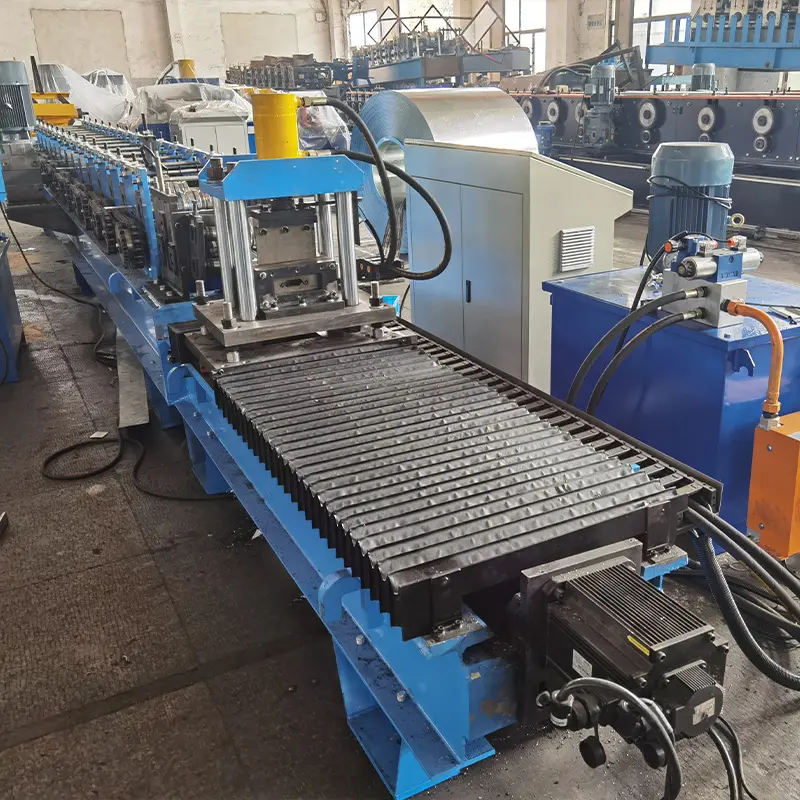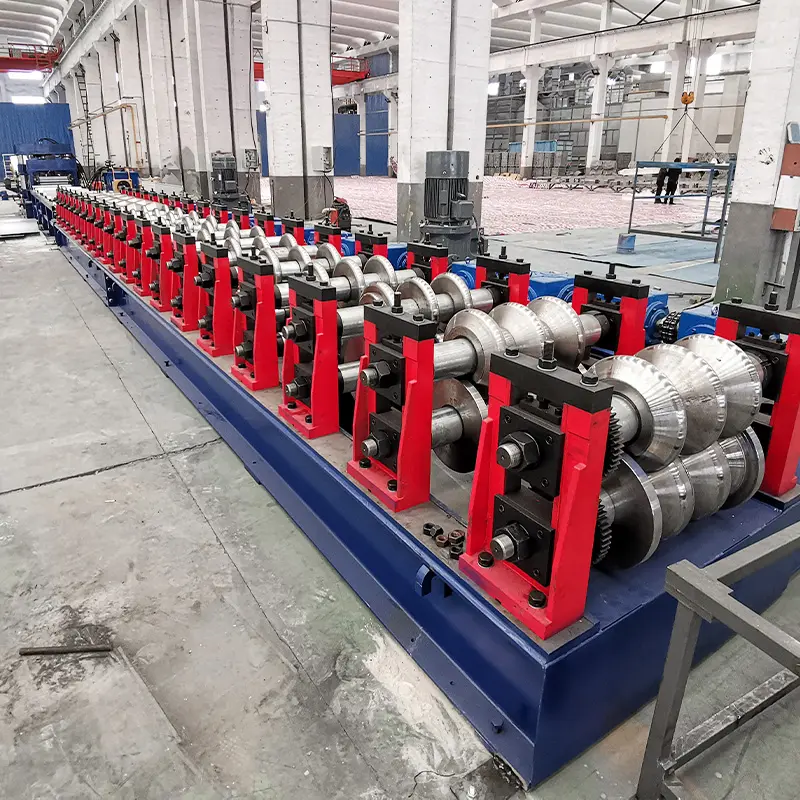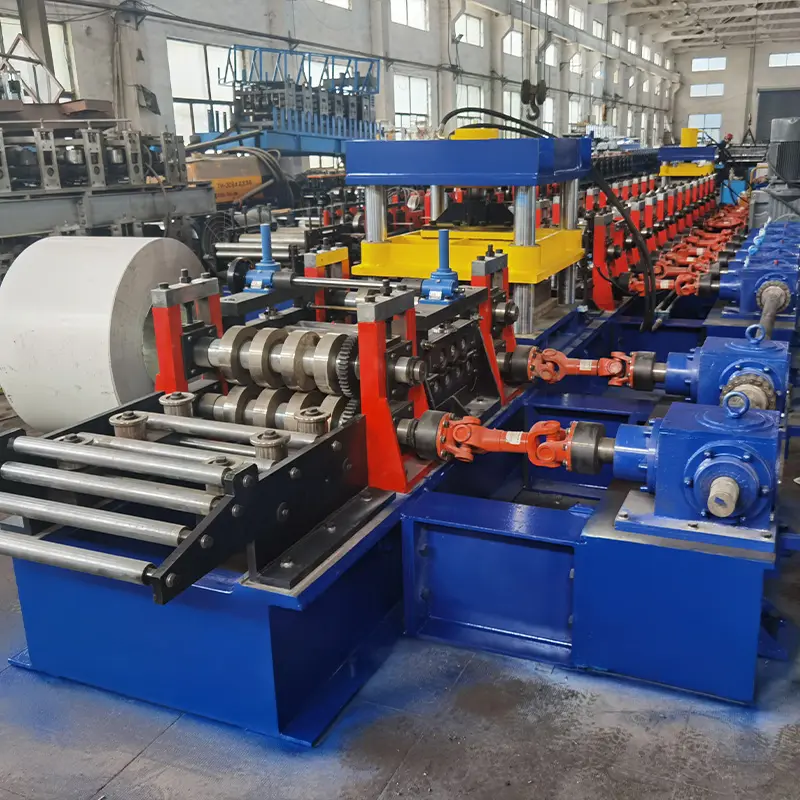In the realm of modern construction and architecture, innovation continues to reshape the landscape of roofing materials and techniques. One notable innovation that has gained remarkable traction is the corrugated roof panel roll forming machine. This marvel of engineering has revolutionized the roofing industry, streamlining the production of corrugated metal sheets that are widely used for roofing and cladding purposes.
ভূমিকা
Corrugated roof panels have been a staple in construction for their durability, weather resistance, and aesthetic appeal. However, the traditional manufacturing process was labor-intensive and time-consuming, hampering the overall efficiency of roofing projects. The advent of corrugated roof panel roll forming machines has addressed these challenges, making the manufacturing process faster, more precise, and cost-effective.

Understanding Corrugated Roof Panel Roll Forming
Corrugated roof panel roll forming is a manufacturing process that involves feeding metal coils through a series of roller dies to gradually shape them into corrugated profiles. This process is automated, precise, and highly efficient. The machine’s design allows for consistent corrugation patterns, ensuring uniformity across the produced panels.
Benefits of Using Corrugated Roof Panel Roll Forming Machines
The shift towards using corrugated roof panel roll forming machines has brought forth a multitude of benefits for the roofing industry:
- Enhanced Efficiency: Traditional methods required multiple steps and considerable time, whereas roll forming machines can produce panels in a single continuous process.
- Cost Savings: Reduced labor requirements and increased production speed lead to significant cost savings for manufacturers and consumers.
- Customization: Modern machines can be adjusted to create various corrugation profiles, catering to different architectural and design needs.
- Material Preservation: The gentle shaping process of roll forming prevents material damage, preserving the structural integrity of the metal.
- Speed and Precision: Roll forming machines can produce large quantities of panels with high precision, ensuring consistent quality.
Key Features to Look for in a Corrugated Roof Panel Roll Forming Machine
When investing in a corrugated roof panel roll forming machine, certain features are essential to consider:
- Material Compatibility: Ensure the machine is capable of handling the specific metal or alloy you intend to use for your panels.
- Roller Design: The quality and design of the rollers will directly impact the accuracy and consistency of the corrugation.
- Automation Level: Opt for machines with advanced automation features for seamless operation and reduced manual intervention.
- Customization Options: Look for machines that allow easy adjustment of corrugation profiles and panel dimensions.
- Durability: Invest in a machine built with robust materials to withstand the demands of continuous operation.
Choosing the Right Corrugated Roof Panel Roll Forming Machine for Your Needs
Selecting the appropriate machine involves assessing your production requirements, budget constraints, and the specific features offered by different manufacturers. Conduct thorough research, read reviews, and if possible, request demonstrations to make an informed decision.
Step-by-Step Guide to Operating a Corrugated Roof Panel Roll Forming Machine
Operating a corrugated roof panel roll forming machine requires a systematic approach:
- Preparation: Set up the machine, ensuring proper alignment and material placement.
- Material Loading: Feed the metal coil into the machine, securing the ends properly.
- Adjustments: Configure the machine settings according to the desired corrugation profile and panel dimensions.
- Initiate Operation: Start the machine and monitor the initial panels to ensure they meet quality standards.
- Continuous Monitoring: Regularly inspect panels for any defects or deviations from the desired specifications.
- Collection and Stacking: As panels are produced, ensure they are collected and stacked carefully to prevent damage.
Maintenance and Care Tips for Longevity
To ensure the longevity and consistent performance of your corrugated roof panel roll forming machine:
- Regular Lubrication: Keep all moving parts adequately lubricated to prevent friction-related issues.
- Routine Inspections: Regularly inspect rollers, belts, and other components for signs of wear or damage.
- Cleaning: Keep the machine clean from debris, dust, and metal shavings that could affect its operation.
- Scheduled Maintenance: Adhere to the manufacturer’s recommended maintenance schedule for optimal performance.

Safety Precautions When Using a Corrugated Roof Panel Roll Forming Machine
Prioritize safety when operating the machine:
- Training: Ensure operators are trained in machine operation, maintenance, and safety protocols.
- Protective Gear: Provide operators with appropriate personal protective equipment, including gloves, goggles, and ear protection.
- Emergency Stop: The machine should be equipped with an easily accessible emergency stop button.
- Proper Ventilation: If the machine produces fumes or heat, ensure the workspace is well-ventilated.
Future Trends in Corrugated Roof Panel Manufacturing
The future of corrugated roof panel manufacturing is poised for more technological advancements. Anticipate:
- Smart Automation: Integration of AI and IoT for real-time monitoring and predictive maintenance.
- Sustainable Practices: Emphasis on eco-friendly materials and energy-efficient production processes.
- Advanced Materials: Exploration of new materials with enhanced durability and performance characteristics.

উপসংহার
The corrugated roof panel roll forming machine has undeniably transformed the roofing industry. Its efficiency, precision, and cost-effectiveness make it a cornerstone of modern construction. As technology advances, we can expect even more innovative strides in corrugated roof panel manufacturing, pushing the boundaries of what’s possible in roofing solutions.
FAQs
- What materials can be used with a corrugated roof panel roll forming machine?
- These machines can work with various metals, including steel, aluminum, and copper.
- Can I create custom corrugation profiles for unique designs?
- Yes, modern machines allow for easy customization of corrugation patterns to suit different design preferences.
- Are there safety considerations when operating these machines?
- Absolutely, operators should be trained, wear protective gear, and follow safety protocols to prevent accidents.
- How do I choose the right machine for my production needs?
- Evaluate your production requirements, budget, and the features offered by different machines before making a decision.
- What does the future hold for corrugated roofing technology?
- The future will likely bring more automation, sustainable practices, and the exploration of advanced materials for better roofing solutions.
Frequently Asked Questions (Supplemental)
1) What tolerances can a Corrugated Roof Panel Roll Forming Machine hold at speed?
- With encoder-based length control and inline laser width gauges, typical cut-length ±0.5–1.0 mm and panel width ±0.7–1.0 mm are achievable at 35–60 m/min, profile- and gauge-dependent.
2) How do I minimize oil-canning and waviness in corrugated panels?
- Ensure entry leveling, maintain consistent coil tension, use progressive radii in early passes, verify roll parallelism, and limit speed on thin gauges (<0.35 mm) or deep corrugations.
3) Which cutoff system is best for coated steel and aluminum coils?
- A servo flying shear or rotary shear with carbide knives synchronized to line speed reduces burring and end deformation compared with mechanical guillotines.
4) Can one machine handle multiple corrugation pitches and depths?
- Yes, with cassette-style tooling or adjustable roll sets and HMI recipes. Expect sub-20-minute changeovers when using pre-gapped cassettes and poka-yoke alignment.
5) What maintenance schedule improves uptime without over-servicing?
- Daily wipe-down and visual checks; weekly roll cleaning and lubrication; monthly alignment and encoder verification; quarterly gearbox vibration/temperature trending via IIoT sensors.
2025 Industry Trends for Corrugated Roof Panel Roll Forming Machines
- Predictive maintenance adoption: IIoT sensors on bearings/gearboxes streaming over OPC UA/MTConnect cut unplanned downtime by 10–20%.
- Energy efficiency: Regenerative VFDs and eco modes lower energy use by 15–30% (kWh per 100 m) versus 2022 baselines.
- Traceability and QA: Inline cameras and laser profilometers log corrugation pitch, depth, and width to batch records for audits and warranty claims.
- Materials shift: Growth in AZ-coated (aluminum-zinc) and pre-painted coils for coastal/corrosive environments; higher use of 3000/5000 series aluminum for lightweight roofing.
- Safety and compliance: More compact lines validated to ISO 13849-1 PL d with stop-time measurements <200 ms and documented risk assessments.
- Faster changeovers: Recipe-driven cassette tooling reduces changeover time to 12–20 minutes for common corrugation profiles.
2025 Benchmarks and KPIs
| KPI | 2023 Typical | 2025 Best-in-Class | Practical Target | Notes | Sources |
|---|---|---|---|---|---|
| Line speed (corrugated panels) | 25–40 m/min | 50–70 m/min | 40–55 m/min | Depends on gauge, coating, profile depth | SME; OEM datasheets |
| Cut length accuracy | ±1.5 mm | ±0.5–1.0 mm | ±1.0 mm | Encoder + servo flying shear | SME Knowledge Hub |
| Changeover time (cassette) | 30–45 min | 12–20 min | ≤25 min | Pre-gapped cassettes + HMI recipes | AMT; OEM case notes |
| Start-up scrap | 3–5% | 1–2% | ≤3% | Guided setup + inline vision | Contractor surveys |
| Energy per 100 m | 1.9–2.6 kWh | 1.3–1.7 kWh | ≤1.9 kWh | Regenerative drives + eco mode | U.S. DOE AMMTO |
| Safety level | Basic CE | ISO 13849-1 PL d | PL c–d | Validated stop-times, interlocks | ISO/CE docs |
References:
- Society of Manufacturing Engineers (SME): https://www.sme.org
- Association for Manufacturing Technology (AMT): https://www.amtonline.org
- U.S. DOE Advanced Materials & Manufacturing Technologies Office: https://www.energy.gov/ammto
- ISO 13849-1 Functional safety: https://www.iso.org/standard/81168.html
Latest Research Cases
Case Study 1: Reducing Oil-Canning on Pre-Painted Corrugated Panels (2025)
Background: A roofing OEM experienced customer complaints of waviness on 0.4 mm pre-painted AZ150 coils at 55 m/min.
Solution: Added entry precision leveller, tightened pass parallelism, implemented inline laser pitch/depth measurement with closed-loop alerts, and reduced speed to 48 m/min for tight-radius profiles.
Results: Cosmetic defects dropped 72%; CpK for width exceeded 1.67; warranty claims reduced by 38% over two quarters; no throughput loss after OEE improvements elsewhere.
Case Study 2: Energy Optimization with Regenerative Drives (2024)
Background: A regional manufacturer sought to cut electricity costs on a Corrugated Roof Panel Roll Forming Machine running two shifts.
Solution: Upgraded to regenerative VFDs, enabled HMI eco mode during idle, and instrumented energy KPIs via MTConnect.
Results: Energy per 100 m fell from 2.2 kWh to 1.6 kWh (−27%); annualized savings $42,000; no adverse impact on cut-length accuracy.
Expert Opinions
- Priya Menon, Senior Roll Forming Engineer, Bradbury Group
Viewpoint: “For corrugated profiles, the first three forming passes define surface quality. Stabilize entry tension and verify roll gaps before tweaking downstream stands.” - David Romero, Operations Director, Formtek Metal Forming
Viewpoint: “Recipe-driven cassettes and pre-gapped tooling make high-mix corrugated SKUs practical—consistent sub-20-minute changeovers are realistic with trained crews.” - Elisa Hoffmann, Functional Safety Auditor, TÜV Rheinland
Viewpoint: “Auditors now expect documented stop-time validation and risk assessments at each nip point to meet ISO 13849-1 PL d—especially on compact, high-speed roofing lines.”
Practical Tools and Resources
- SME Knowledge Hub: Roll forming best practices and tolerancing — https://www.sme.org
- AMT insights on metal forming productivity — https://www.amtonline.org
- DOE Better Plants energy calculators for manufacturing — https://betterbuildingssolutioncenter.energy.gov/better-plants
- MTConnect and OPC UA for machine data/traceability — https://www.mtconnect.org | https://opcfoundation.org
- National Coil Coating Association technical bulletins (pre-painted coil forming) — https://www.coilcoating.org
- ISO 13849-1 overview and purchase — https://www.iso.org/standard/81168.html
Keyword integration examples:
- A Corrugated Roof Panel Roll Forming Machine with cassette tooling and HMI recipes enables sub-20-minute profile changeovers.
- Energy-optimized Corrugated Roof Panel Roll Forming Machines using regenerative VFDs cut kWh per 100 meters by up to 30%.
- For coastal projects, choose Corrugated Roof Panel Roll Forming Machines proven on AZ-coated coils to ensure corrosion resistance and finish quality.
Citations and further reading:
- SME: https://www.sme.org
- AMT: https://www.amtonline.org
- U.S. DOE AMMTO: https://www.energy.gov/ammto
- ISO 13849-1: https://www.iso.org/standard/81168.html
Last updated: 2025-10-24
Changelog: Added 5 supplemental FAQs; 2025 trends with KPI table and references; two recent case studies; expert viewpoints; and curated tools/resources with keyword-integrated examples.
Next review date & triggers: 2026-04-24 or earlier if safety standards (ISO 13849), coil/coating specs, or OEM features (cassette tooling, inline vision QA, regenerative drives) change.
